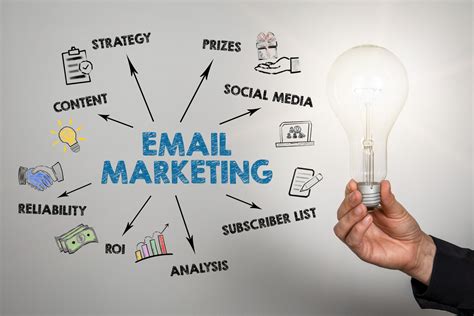In today's fast-paced digital world, effective communication has become the key to success for businesses of all sizes. And when it comes to reaching your target audience, email marketing remains one of the most powerful tools in your arsenal. But how do you take your email campaigns to the next level and ensure maximum engagement and conversion?
Here, we present you with ten expert strategies that will revolutionize the way you approach email marketing. From crafting attention-grabbing subject lines to optimizing your email design, these tips will empower you to connect with your audience in a compelling and impactful way.
First and foremost, you need to understand the importance of creating a sense of urgency within your emails. By using persuasive language and time-limited offers, you can create a fear of missing out (FOMO) among your subscribers, prompting them to take immediate action.
Furthermore, personalization is the key to effectively engage your readers. Take advantage of the data at your disposal to tailor your emails to individual preferences and demographics. Addressing your customers by their first name and providing content that is relevant and valuable to their interests will significantly increase open rates and click-throughs.
Building an Engaging Email List
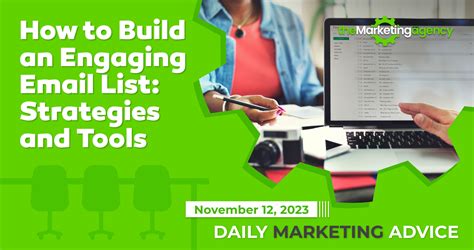
In order to create a successful and effective email marketing campaign, one must begin by building an engaging email list. This involves curating a group of interested subscribers who are likely to engage with your content and take action.
| 1. | Attracting Targeted Subscribers: Focus on attracting individuals who have a genuine interest in your products or services. Utilize various online channels, such as social media, blog posts, and targeted advertisements to drive traffic to your opt-in forms. |
| 2. | Optimized Sign-up Forms: Create visually appealing and user-friendly sign-up forms that are easy to locate on your website. Keep the form fields concise and specific, ensuring that potential subscribers understand the benefits of signing up. |
| 3. | Incentives for Subscription: Offer value-add incentives to entice visitors to subscribe to your email list. This can be in the form of exclusive content, discounts, free resources, or any other compelling offering that aligns with your target audience's interests. |
| 4. | Segmentation and Personalization: Segment your email list based on various criteria, such as demographics, purchase history, or engagement level. This allows you to tailor your email content specifically to the interests and needs of different subscriber segments, increasing engagement and conversion rates. |
| 5. | Consistent and Relevant Communication: Regularly communicate with your subscribers by sending out relevant and valuable content. This helps build a relationship of trust and credibility with your audience, encouraging their continued engagement. |
| 6. | Opt-in Confirmation and Double Opt-in: Implement opt-in confirmation and double opt-in processes to ensure the quality of your email list. This reduces the likelihood of fake or inactive email addresses and ensures that subscribers are genuinely interested in hearing from you. |
| 7. | Engaging Welcome Emails: Create a compelling welcome email series to engage new subscribers from the start. Use this opportunity to introduce your brand, provide valuable information, and set expectations for future email communications. |
| 8. | Encourage Social Sharing: Add social sharing buttons to your email campaigns, allowing subscribers to easily share your content with their connections. This can help expand your reach and attract new subscribers who align with your target audience. |
| 9. | Optimize for Mobile: Ensure that your email campaigns are mobile-friendly and responsive. With the increasing use of mobile devices, it is crucial that your content displays properly and is easy to interact with on smaller screens. |
| 10. | Regular List Maintenance: Periodically review and clean your email list by removing inactive or unengaged subscribers. This helps maintain a high deliverability rate and ensures that your messages are reaching those who are truly interested in receiving them. |
Captivating Subject Lines: The Key to Compelling Email Content
In the realm of email marketing, one important aspect stands above all others: crafting a truly captivating subject line. This small yet mighty text holds the power to entice recipients, driving them to open and engage with your email content. A well-crafted subject line can make or break the success of your email campaigns, demanding careful attention and consideration.
As you endeavor to create subject lines that captivate and convince, it is crucial to think beyond the usual norms and explore various synonyms and creative options. By incorporating originality, emotional appeal, and strategic intentions, you can elevate your subject lines to new heights, fostering greater email engagement and conversions.
When constructing an irresistible subject line, it is essential to understand your target audience and tailor your language to their preferences and interests. By knowing their pain points, desires, and values, you can speak directly to their needs, nurturing a strong connection and enhancing the likelihood of open rates and conversions.
Additionally, embracing the power of personalization can significantly impact the effectiveness of your subject lines. By addressing recipients by name or tailoring the content based on their previous interactions or purchase history, you can create a sense of exclusivity and relevance, encouraging higher open rates and click-through rates.
Experimentation and A/B testing play a vital role in honing your subject line skills. By testing different variations, you can uncover the most compelling language, length, and format that resonates with your audience. Analyzing the results and making data-driven decisions will enable continuous improvement and optimize the performance of your email campaigns.
Lastly, never underestimate the importance of concise and impactful language in subject lines. By using action verbs, intriguing adjectives, or teasing snippets of content, you can create a sense of urgency and curiosity, compelling recipients to click through and explore further.
In conclusion, the art of crafting a compelling subject line is fundamental to achieving email marketing success. Through originality, audience targeting, personalization, experimentation, and concise language, you can unleash the full potential of your email campaigns, fostering increased engagement, conversions, and ultimately, business growth.
Customizing Your Emails to Boost Open Rates
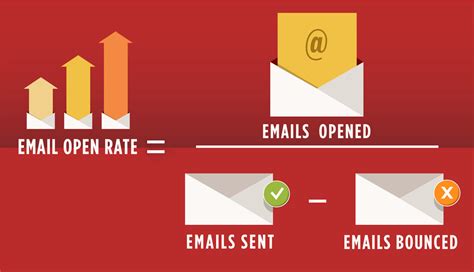
When it comes to enhancing the effectiveness of your email correspondences, personalizing your messages can make a world of difference. By tailoring your emails to suit the unique interests, preferences, and characteristics of your target audience, you can significantly increase open rates and engagement levels.
1. Segment Your Email List: Divide your subscribers into distinct groups based on demographics, interests, purchase history, or behavior. This way, you can create more relevant and targeted email content.
2. Use Dynamic Content: Employ dynamic email content that can be customized according to the recipient's profile, such as their name, location, or previous interactions with your brand. This personal touch can create a sense of familiarity and connection.
3. Craft Compelling Subject Lines: Grab the attention of your recipients with enticing subject lines that highlight the value or benefits they can expect from opening your email. Experiment with different approaches and A/B test to determine what works best.
4. Address Recipients by Name: To make your emails feel more personal, address recipients by their names in the greeting or introduction. This small detail can make a significant impact on engagement rates.
5. Leverage Behavioral Triggers: Set up automated emails triggered by specific actions or events, such as abandoned carts or completed purchases. Based on these behaviors, deliver personalized follow-up messages to nurture your leads.
6. Incorporate User Preferences: Allow subscribers to indicate their preferences and interests during the signup process. Use this information to send targeted emails that align with their specific desires and needs.
7. Provide Exclusive Offers: Reward your loyal subscribers with exclusive offers or discounts tailored to their previous interactions or purchase history. This personal touch can entice them to open and engage with your emails.
8. Create a Conversational Tone: Write your emails as if you're having a one-on-one conversation with each recipient. Use conversational language and address their pain points or aspirations to establish a deeper connection.
9. Test and Optimize: Continuously test different personalization strategies to determine what resonates best with your audience. Analyze open rates, click-through rates, and conversion rates to refine your approach and maximize engagement.
10. Monitor and Adapt: Regularly monitor the performance of your personalized email campaigns. Identify patterns, trends, and feedback from your audience to adapt your content and structure accordingly.
By investing time and effort into personalizing your emails, you can captivate your audience, inspire trust, and increase the likelihood of recipients opening and engaging with your messages.
Creating Valuable and Relevant Content
In today's rapidly evolving digital landscape, it is imperative for businesses to capture the attention of their target audience through effective email marketing strategies. One key aspect of achieving this is by creating valuable and relevant content that resonates with the recipients. By understanding the needs and interests of your subscribers, you can craft compelling messages that engage and convert.
Here are ten actionable steps to help you develop meaningful content for your email marketing campaigns:
- Understand Your Audience: Conduct thorough research to identify your target demographic, their preferences, and pain points. This information will enable you to create content that addresses their specific needs.
- Personalize Your Messages: Tailor your emails based on individual subscriber data, such as their name, location, and purchase history. Personalization enhances engagement and fosters a sense of connection with your brand.
- Segment Your List: Divide your email list into targeted segments based on factors like demographics, interests, and previous interactions. This allows you to deliver content that is highly relevant to each segment, increasing open rates and conversions.
- Provide Value: Deliver content that offers practical tips, useful information, industry insights, or exclusive offers. Make sure each email brings something of value to your subscribers, giving them a reason to open, read, and take action.
- Be Consistent: Maintain a consistent tone, style, and frequency in your email communications. This helps build brand recognition and establishes trust with your subscribers.
- Use Compelling Subject Lines: Craft attention-grabbing subject lines that pique curiosity and entice recipients to open your emails. Avoid misleading or clickbait subject lines, as they can lead to a loss of trust.
- Optimize for Mobile: With the increasing use of smartphones, ensure that your emails are mobile-friendly and display well on different devices. A seamless mobile experience will enhance engagement and conversion rates.
- Include Clear Call-to-Actions: Clearly state the desired action you want your subscribers to take, whether it is making a purchase, signing up for a webinar, or sharing your content on social media. Well-placed and compelling call-to-actions can significantly boost your campaign's success.
- A/B Test Your Content: Experiment with different elements, such as subject lines, email designs, and content formats, to ascertain the most effective strategies for your audience. A/B testing allows you to optimize your content for maximum impact.
- Analyze and Adapt: Regularly analyze the performance of your email campaigns through metrics like open rates, click-through rates, and conversions. Use this data to refine your content and continue delivering valuable emails to your subscribers.
By following these steps and focusing on creating valuable and relevant content, you can maximize the effectiveness of your email marketing campaigns, drive engagement, and achieve your business goals.
Enhancing Emails for Mobile Devices
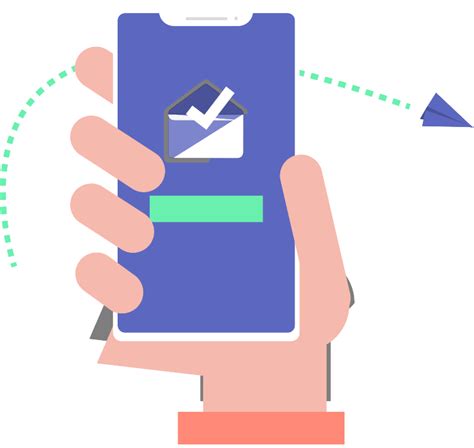
As the number of mobile users continues to rise, it is crucial for businesses to optimize their email marketing campaigns for mobile devices. Mobile optimization ensures that emails are displayed correctly and provide a seamless user experience across various screen sizes and operating systems.
When crafting emails for mobile devices, it is essential to consider factors such as responsive design, concise content, and mobile-friendly call-to-action elements. Utilizing a responsive email design allows the email layout to adapt to different screen sizes, ensuring that it is easily readable and visually appealing on smartphones and tablets.
Furthermore, conciseness plays a significant role in mobile email optimization. Mobile users often have limited time and attention span, so it is vital to deliver the message efficiently and concisely. Use clear and concise language to convey the main points of your email, avoiding lengthy paragraphs or bulky blocks of text.
In addition to concise content, optimizing call-to-action elements is essential for mobile devices. The buttons or links guiding recipients to take action should be large enough for easy tapping on touch screens, and they should be strategically placed within the email to ensure maximum visibility.
Considering the diversity of mobile operating systems and email clients, it is crucial to test your emails across various devices and platforms. This testing phase allows you to identify any display or rendering issues and make necessary adjustments to ensure a consistent user experience across different devices.
Lastly, optimizing images for mobile devices is crucial for faster loading times and better overall user experience. Compress images without compromising their quality to minimize the email file size, enhancing load times for mobile users.
By following these practices, businesses can enhance the effectiveness of their email marketing campaigns on mobile devices, reaching and engaging a broader audience to drive success and achieve the desired results.
Enhance Your Email Campaigns: The Importance of Testing and Segmenting
In order to optimize the effectiveness of your email campaigns, it is essential to invest time and effort into testing and segmenting your emails. By implementing these strategies, you can significantly improve your results and achieve higher engagement rates.
When it comes to testing your emails, it is crucial to experiment with various elements such as subject lines, call-to-action buttons, and overall design. This allows you to identify the most effective strategies for your target audience and increase the likelihood of them opening, reading, and taking action on your emails. A/B testing is a popular technique where you create two versions of an email and compare their performance to determine the best approach.
Additionally, segmenting your email list based on specific criteria can greatly enhance the relevance and personalization of your messages. By dividing your subscribers into different groups or segments, you can tailor your content to their unique preferences, needs, and behaviors. This targeted approach increases the chances of your emails resonating with each individual recipient, leading to higher open rates, click-through rates, and conversions.
When segmenting your audience, consider factors like demographics, purchase history, engagement level, and previous interactions with your brand. Utilize tools and software that allow you to gather and analyze this data effectively, ensuring that your segmentation strategy is based on accurate and up-to-date information.
Remember, testing and segmenting your emails may require some initial effort, but the results are well worth it. These strategies enable you to deliver more personalized and relevant content to your subscribers, cultivating stronger relationships and driving better outcomes for your email marketing campaigns. Implementing a comprehensive testing and segmentation strategy will undoubtedly contribute to the long-term success and growth of your business.
Optimizing the Effectiveness of Call-to-Action Buttons
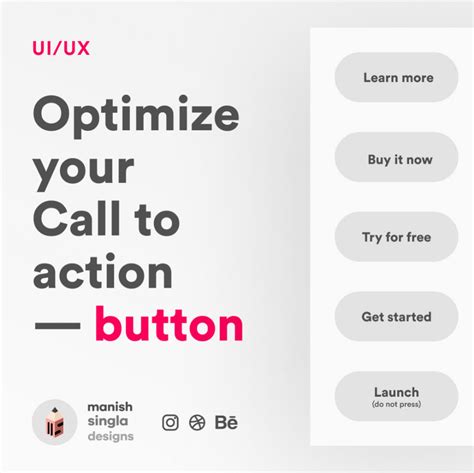
Incorporating call-to-action buttons strategically in your email marketing campaigns can significantly enhance user engagement and conversion rates. These buttons serve as powerful tools to compel your audience to take desired actions, such as making a purchase, signing up for a newsletter, or downloading a resource.
When designing your call-to-action buttons, it is essential to prioritize clarity and simplicity. Using concise and action-oriented language on the buttons can effectively communicate the intended action to your audience. Instead of generic phrases like "Click Here," opt for more compelling and specific terms, such as "Get Started," "Join Now," or "Claim Your Free Trial."
Another crucial factor to consider is the button's placement within the email. Positioning the call-to-action buttons prominently and above the fold can increase their visibility, ensuring that recipients are more likely to notice and act upon them. Experimenting with different button sizes, colors, and designs can also help draw attention and create a sense of urgency.
It is equally important to make sure that the buttons are mobile-friendly. With mobile devices accounting for a significant portion of email opens, optimizing your call-to-action buttons for mobile responsiveness will ensure a seamless user experience across all devices. Test the buttons' functionality and appearance on various screen sizes to guarantee a consistent experience for your mobile audience.
Furthermore, consider adding a sense of urgency to your call-to-action buttons. Incorporating phrases like "Limited Time Offer" or "Today Only" can create a sense of scarcity and prompt recipients to take immediate action. However, be cautious not to overuse urgency, as it may diminish its effectiveness over time.
Tracking and analyzing the performance of your call-to-action buttons is crucial for optimizing their impact. Utilize email marketing analytics to measure click-through rates, conversion rates, and overall campaign success. Consider conducting A/B tests to compare different button variations and determine the most effective design and messaging.
| Key takeaways: |
| • Use clear and concise language on your call-to-action buttons. |
| • Position the buttons prominently and above the fold. |
| • Optimize the buttons for mobile responsiveness. |
| • Incorporate a sense of urgency when appropriate. |
| • Track and analyze the performance of your buttons. |
Monitoring and Analyzing Your Email Metrics
Understanding and evaluating the performance of your email marketing campaigns is crucial for optimizing their effectiveness and achieving desired results. By monitoring and analyzing the various email metrics, you can gain valuable insights into the reception, engagement, and conversion rates of your messages. In this section, we will explore the importance of tracking key metrics and provide guidance on how to interpret and utilize the data to enhance your email marketing strategy.
| Metric | Description |
|---|---|
| Open Rate | The percentage of recipients who open your email. |
| Click-Through Rate (CTR) | The ratio of recipients who clicked on a link within your email to the total number of recipients. |
| Bounce Rate | The percentage of email addresses that did not receive your message due to various reasons, such as invalid addresses or full inboxes. |
| Conversion Rate | The percentage of recipients who took a desired action after clicking on a link in your email, such as making a purchase or filling out a form. |
| List Growth Rate | The rate at which your email subscriber list is expanding. |
By regularly monitoring these metrics and evaluating their trends over time, you can identify areas of strengths and weaknesses in your email marketing strategy. For instance, a low open rate might indicate that your subject lines are not engaging enough, while a high bounce rate suggests issues with your mailing list quality. Analyzing the click-through rate can help determine the effectiveness of your call-to-action and content relevancy. By analyzing conversion rates, you can assess the impact of your emails on driving desired actions.
Additionally, comparing your metrics against industry benchmarks can provide valuable context and help set realistic goals. Understanding how your email performance measures up to industry standards can guide your efforts towards improving specific areas that are underperforming.
In conclusion, monitoring and analyzing your email metrics is essential for optimizing the performance of your email marketing campaigns. By gaining insights from these metrics, you can make data-driven decisions and implement targeted strategies to improve engagement, conversions, and overall campaign success. Regularly evaluating and adjusting your approach based on these metrics will enable you to continually enhance the effectiveness of your email marketing efforts.
Ensuring Deliverability and Preventing Spam Filters
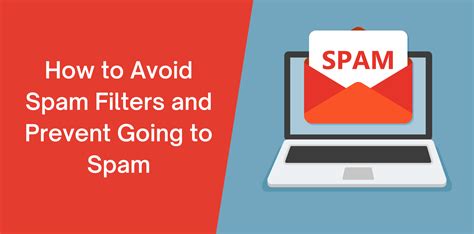
In order to ensure that your email marketing campaigns are successful and reach your target audience, it is crucial to focus on factors that can affect deliverability and avoid being flagged as spam. By implementing best practices and following proper guidelines, you can maximize the chances of your emails reaching the intended recipients and achieving the desired results.
First and foremost, it is important to maintain a clean and updated email list. Regularly go through your subscriber list and remove any inactive or invalid email addresses. This will not only improve the deliverability rate but also help prevent your emails from being marked as spam due to bounces or failed deliveries.
Another key aspect to consider is the reputation of your email service provider. Research and choose a reputable and trustworthy provider with a proven track record of delivering emails to the inbox. A reliable email service provider will have strong relationships with internet service providers (ISPs) and will take measures to prevent their IP addresses from being blacklisted.
When crafting your email content, it is essential to avoid trigger words and phrases commonly associated with spam. These can include words like "free," "buy now," or "limited time offer." Instead, focus on providing valuable and relevant content to your subscribers, ensuring that your emails are personalized and tailored to their interests and needs.
Furthermore, it is worth considering the design and structure of your emails. Use a well-designed template that is mobile-responsive and optimized for different email clients. Avoid using excessive graphics or images, as they can trigger spam filters. Also, make sure that your emails have a clear and prominent unsubscribe link to comply with anti-spam regulations and provide an easy way for recipients to opt-out if they no longer want to receive your emails.
Lastly, regularly monitor and analyze your email deliverability and engagement metrics. Pay attention to factors like open rates, click-through rates, and bounce rates. By observing these metrics, you can identify any potential issues and take corrective actions to improve your email performance and overall deliverability.
Continuous Enhancement and Refinement of Your Email Marketing Approach
In order to continuously improve and refine your approach to email marketing, it is essential to adopt a dynamic and adaptive mindset. Embracing an ongoing process of analysis, experimentation, and optimization will empower you to stay ahead of the competition and enhance the effectiveness of your email marketing strategy.
One crucial aspect of refining your email marketing strategy is to consistently evaluate your target audience. Understanding their preferences, needs, and behaviors will enable you to develop more tailored and relevant email content. Utilize surveys, feedback forms, and analytics tools to gather insights and anticipate their evolving expectations.
Furthermore, regularly assessing the performance metrics of your email campaigns is crucial. Monitoring key metrics such as open rates, click-through rates, and conversion rates will provide valuable data to identify areas for improvement. Test different subject lines, CTAs, and email layouts to identify what resonates most effectively with your audience.
Another key component of refining your strategy is to stay updated with the latest trends and best practices. Being aware of emerging technologies and industry advancements will allow you to align your email marketing approach with current standards and leverage new opportunities. Stay connected with industry leaders, attend relevant webinars, and engage in networking events to gain valuable insights and inspiration.
Furthermore, segmenting your email list and personalizing your content are vital elements of refining your strategy. By categorizing subscribers based on demographics, interests, or purchasing history, you can deliver highly targeted and personalized content that resonates with each segment. Use automation tools and dynamic content to streamline this process and ensure a tailored experience for each recipient.
Addtionally, A/B testing is a powerful tool for refining your email marketing strategy. Testing different variables such as subject lines, visuals, and calls to action can provide valuable insights into what drives engagement and conversions. Experiment with different combinations and analyze the results to optimize your future campaigns.
Lastly, seeking feedback and insights from your recipients is invaluable. Encourage subscribers to provide feedback, suggestions, and comments to gain a deeper understanding of their experience and expectations. Take their feedback into consideration and make adjustments accordingly to enhance the overall effectiveness of your email marketing strategy.
- Continually evaluate your target audience's preferences, needs, and behaviors
- Regularly analyze key performance metrics to identify areas for improvement
- Stay updated with industry trends and best practices
- Segment your email list and personalize your content
- Utilize A/B testing to optimize key variables
- Solicit feedback and insights from your recipients
FAQ
Why is building a targeted and segmented email list important?
Building a targeted and segmented email list is important because it allows you to tailor your email content specifically to the interests and needs of different segments of your audience. By targeting the right people with relevant content, you can increase the chances of engagement and conversions, resulting in a more successful email marketing campaign.
